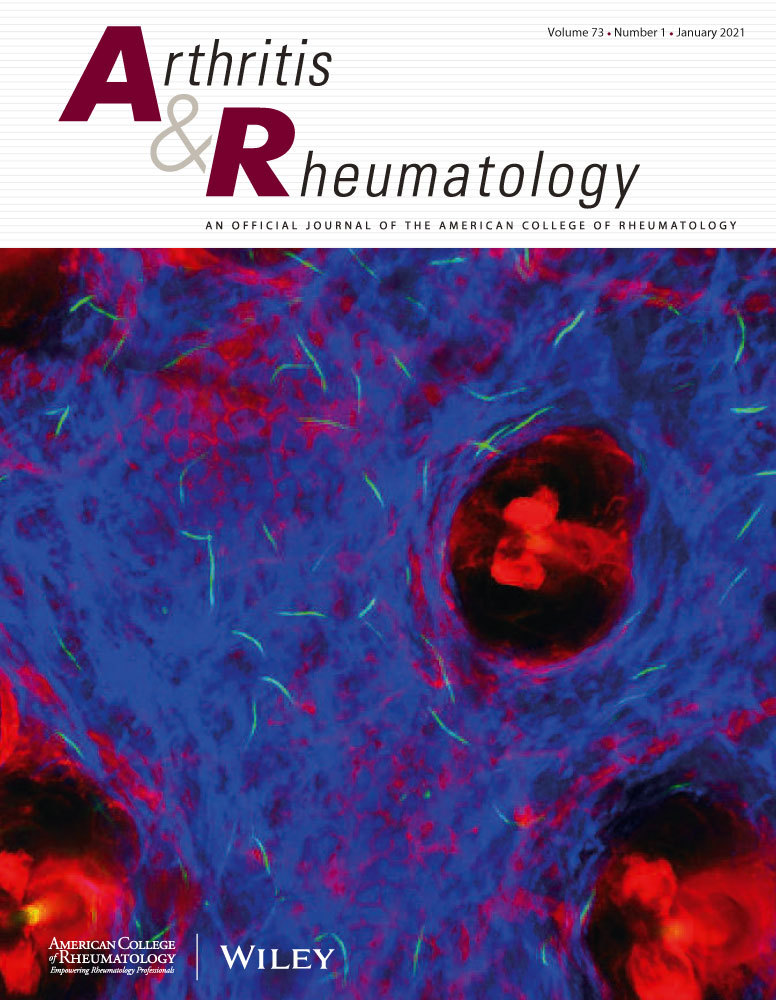儿童自身免疫的精准医学:lenolisib治疗由活化pi3k - δ综合征(APDS)引起的儿童期狼疮性肾炎。
IF 11.4
1区 医学
Q1 RHEUMATOLOGY
引用次数: 0
摘要
目的利用途径特异性治疗和先进的空间蛋白质组学研究活化pi3k - δ综合征1型(APDS1)患者狼疮性肾炎(LN)的机制基础和治疗反应。方法对1例18岁遗传确诊APDS1 (PIK3CD c.3061G>A, p.E1021K突变)的难治性V型LN患者进行机制研究。通过临床参数和外周血淋巴细胞流式细胞术评估对选择性PI3Kδ抑制剂leniolisib的反应。采用多路复用离子束成像飞行时间光谱法(MIBI-TOF)对肾脏组织免疫结构进行了表征,比较了12例儿童发病LN患者(cLN)和5例健康对照(HC)的APDS1-LN组织特征。结果:sleniolisib治疗使过度活跃的PI3Kδ信号正常化,在常规免疫抑制剂治疗失败三年后,导致蛋白尿、补体水平和外周水肿的显著改善。MIBI-TOF空间蛋白质组学显示了明显的组织特异性免疫病理,CD8+ T细胞比例显著增加(APDS1为21.6%,典型LN为12.0%,p=0.0410), M1巨噬细胞(APDS1为42.0%,典型LN为9.0%,p=0.1445)聚集在肾小球周围,并伴有免疫复合物沉积。这一免疫特征与PI3Kδ通路对淋巴细胞耗竭和炎症表型的影响一致。结论该研究通过证明apds1相关LN具有特定的组织免疫特征,并响应致病分子途径的靶向抑制,从而推动了风湿病学的发展。我们的研究结果为自身免疫的遗传驱动机制提供了见解,并为原发性免疫缺陷中难治性自身免疫表现的途径特异性治疗方法提供了支持。本文章由计算机程序翻译,如有差异,请以英文原文为准。
Precision Medicine in Pediatric Autoimmunity: Leniolisib Treatment of Childhood-Onset Lupus Nephritis Due to Activated PI3K-Delta Syndrome (APDS).
OBJECTIVE
To investigate the mechanistic underpinnings and treatment response of lupus nephritis (LN) in activated PI3K-delta syndrome type 1 (APDS1) using pathway-specific therapy and advanced spatial proteomics.
METHOD
We conducted mechanistic investigation of refractory class V LN in an 18-year-old female with genetically confirmed APDS1 (PIK3CD c.3061G>A, p.E1021K mutation). Response to leniolisib, a selective PI3Kδ inhibitor, was evaluated through clinical parameters and flow cytometry of peripheral blood lymphocytes. Kidney tissue immune architecture was characterized using Multiplexed Ion Beam Imaging Time-of-Flight Spectrometry (MIBI-TOF), comparing the APDS1-LN tissue signature with 12 childhood-onset LN patients (cLN) and 5 healthy controls (HC).
RESULTS
Leniolisib treatment normalized hyperactive PI3Kδ signaling, resulting in significant improvements in proteinuria, complement levels, and peripheral edema after failing three years of conventional immunosuppressives. MIBI-TOF spatial proteomics revealed a distinct tissue-specific immunopathology with significantly increased proportions of CD8+ T cells (21.6% in APDS1 vs. 12.0% in typical LN, p=0.0410) and M1 macrophages (42.0% in APDS1 vs. 9.0% in typical LN, p=0.1445) clustering around glomeruli with immune complex deposition. This immune signature aligns with the constitutively active PI3Kδ pathway's effect on lymphocyte exhaustion and inflammatory phenotype.
CONCLUSION
This investigation advances rheumatology by demonstrating that APDS1-associated LN displays a specific tissue immune signature and responds to targeted inhibition of the causative molecular pathway. Our findings provide mechanistic insights into genetic drivers of autoimmunity and support pathway-specific therapeutic approaches for refractory autoimmune manifestations in primary immunodeficiencies.
求助全文
通过发布文献求助,成功后即可免费获取论文全文。
去求助
来源期刊

Arthritis & Rheumatology
RHEUMATOLOGY-
CiteScore
20.90
自引率
3.00%
发文量
371
期刊介绍:
Arthritis & Rheumatology is the official journal of the American College of Rheumatology and focuses on the natural history, pathophysiology, treatment, and outcome of rheumatic diseases. It is a peer-reviewed publication that aims to provide the highest quality basic and clinical research in this field. The journal covers a wide range of investigative areas and also includes review articles, editorials, and educational material for researchers and clinicians. Being recognized as a leading research journal in rheumatology, Arthritis & Rheumatology serves the global community of rheumatology investigators and clinicians.
 求助内容:
求助内容: 应助结果提醒方式:
应助结果提醒方式:


